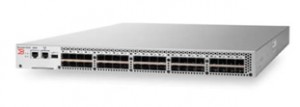PortErrShow outputÂ
Frames tx/rx N/A
counters representing the number of frames transmitted
Enc_in
8bit/10bit encoding errors inside frame. Words inside of frames are encoded,
if this encoding is corrupted or an error is detected enc_in is generated.”
”Minimum compliance with the link bit error rate specification on a link continuously”
”receiving frames would cause approximately one error every 20 minutes.”
”Re-initialisation / reboots of the associated Nx-port can also cause these errors.”
Crc_err
crc errors â a mathematical formula generates counters at sending port,
receiving port uses the same formula to check and compare.
”Statistically, crc_err and enc_out errors together imply GBIC/SFP problem.”
”Also see âbad_eofâ below.”
Too_long
FC frames are 2148 bytes maximum. Frames that were longer than the FC
maximum (SOF+header+2112bytes+CRC+EOF). If an eof is corrupted or data
generation is incorrect a too_long error is reported.
Too_short
The too_short error statstics counter is incremented whenever a frame,
bounded by an SOF and EOF, is received and the number of words between the SOF
and EOF is less than 7 words (6 words header plus 1 word CRC), i.e. 38 bytes (not 48)
including the SOF and EOF.
‘This could be caused by the transmitter, or an unreliable link.”
Bad_eof
After a loss of synchronization error, continuous-mode alignment allows
the receiver to re-establish word alignment at any point in the incoming bit stream
while the receiver is operational. If such a re-alignment occurs, detection of the
resulting error condition is dependant upon higher level functions (eg: invalid CRC,
missing EOF)
Enc_out
8bit/10bit encoding errors occurred in words (ordered sets) outside of the
FC frame. Words outside of frames are encoded, if this encoding is corrupted or an
error is detected enc_out is generated. It indicates a problem if it increments faster
than the link-bit error rate allows, approximately once every 20 minutes for 1 Gbit/s.
”Statisically, enc_out errors on their own imply a cable/connector problem.”<br>Enc_out”
”errors and crc_err together imply GBIC/SFP problem.”
”Such errors are also expected every time a user brings a port down and up (i.e. reboot”
”host, power-cycle storage subsystem, unplug/plug cable or portdisable/portenable”
”etc).Such errors will also be generated on a link which has a 1Gbit/s port connected”
”to a 2Gbit/s port when autonegotiation is turned off.”
Disc c3
Discard class 3 errors could be generated by switch when devices send
frames without FLOGIing first or with an invalid destination. This error is just
reporting that a discard occurred.
Link-fail
If a port remains in the LR Receive State for a period of time greater than a
timeout period (R_A_TOV), a link reset protocol timeout shall be detected which
results in a link failure condition (enter the NOS transmit state). The link failure also
indicates that loss of signal or loss of sync lasting longer than the R_ATOV value was
detected while not in the offline state.
Loss sync
Synchronisation failures on either bit or transmission-word boundaries are
not separately identifiable and cause loss-of-synchronisation errors.
”Such errors are also expected every time a user brings a port down and up (i.e. reboot ”
”host, power-cycle storage subsystem, unplug/plug cable or portdisable/portenable ”
”etc).”
Loss sig
Occurs when a signal is transmitted but none is being received on the same
port.
”Such errors are also expected every time a user brings a port down and up (i.e. reboot ”
”host, power-cycle storage subsystem, unplug/plug cable or portdisable/portenable ”
”etc).”
Frjt
If the fabric canât process a class 2 frame a F_RJT is returned
Frbsy
If a fabric canât deliver a class 2 frame within E_D_TOV frame will be<br>
discarded and a F_BSY returned
